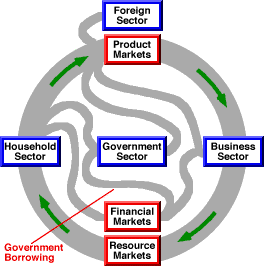
|
|
LEGAL CLAIM: Ownership of the physical goods, services, and resources that make up the real side of the economy. Legal claims are a key feature of the paper, or financial side of the economy. Transferring legal claims is the primary method of diverting income from household saving to investment and government borrowing. Legal-claim buyers loan income and legal-claim sellers borrower income.
Visit the GLOSS*arama
|
|


|

|
                           GOVERNMENT BORROWING: The acquisition of funds through the financial markets by the government sector which are used to finance government expenditures. In terms of the simple circular flow model, this is one of two basic demands for household saving diverted into financial markets. The other is investment borrowing. Government borrowing is also one of two methods of financing government expenditures. The other is taxes. Government borrowing is one of two sources of funds used by the government sector to pay for government expenditures. The primary source of financing comes from taxes. Government borrowing is necessary when the government sector spends more than it collects in taxes.Working the Financial MarketsThe government sector obtains funds used for government purchases through the financial markets. The function of financial markets is to divert household sector income',500,400)">income to other expenditures, especially investment expenditures and government purchases. They accomplish this by trading legal claims.- Savers and Buyers: On one side of the financial markets, savers in the household sector buy legal claims and in so doing divert income to the financial markets. They give up income in exchange for the legal claims to the ownership of physical assets or to future repayment of income.
- Borrowers and Sellers: On the other side, borrowers in the business and government sectors sell legal claims and in so doing obtain income from the financial markets that they use to undertake expenditures. The borrowers give up legal claims in exchange for income.
Spending More, Taxing LessIf the government sector fails to collect a sufficient amount of the tax revenue needed to cover all expenditures, it must obtain the rest by borrowing through the financial markets. All levels of government--federal, state, and local--engage in borrowing to finance expenditures.The federal level regularly borrows to finance the federal deficit by issuing Treasury securities. State and local governments also borrow needed funds. Local communities finance school buildings, street construction, and other capital improvements by borrowing. State governments borrow to finance public capital projects, such as university buildings and highway construction. Government borrowing is quite common because the voting public tends to favor lower taxes, but more government spending. They enjoy the public goods provided by the government sector, but would rather not pay the necessary taxes. If taxes fall short, then borrowing is the only answer. The Circular Flow| The Circular Flow |  |
Government borrowing by the government sector can be illustrated with the circular flow model. The circular flow captures the continuous movement of production, consumption, income, and factor payments between producers and consumers.A basic representation of the circular flow is displayed to the right. The components of this model are the four macroeconomic sectors--household, business, government and foreign--and the three macroeconomic markets--product, resource, and financial. The household sector at the far left contains the consuming population of the economy. The business sector at the far right includes all of the producers. The government sector is positioned in the middle of the diagram and the foreign sector is at the very top. The product markets near the top of the flow direct production from the business sector to the household sector in exchange for payment flowing in the opposite direction. The resource markets at the bottom of the flow direct factor services from the household sector to the business sector in exchange for payment flowing in the opposite direction. The financial markets located just above the resource markets divert saving from the household sector to business and government borrowing. The circular flow indicates that the income used by the household sector to purchase goods through the product markets is obtained by selling factor services through the resource markets. It also indicates that the revenue used by the business sector to pay for factor services obtained through the resource markets is generated by selling goods through the product markets. Government borrowing is the flow between the financial markets and the government sector. The government sector obtains income used for government purchases from the saving diverted into the financial markets from the household sector.

Recommended Citation:GOVERNMENT BORROWING, AmosWEB Encyclonomic WEB*pedia, http://www.AmosWEB.com, AmosWEB LLC, 2000-2024. [Accessed: April 28, 2024].
Check Out These Related Terms... | | | | | | | | | | |
Or For A Little Background... | | | | | |
And For Further Study... | | | | | | | | | | |
Search Again?
Back to the WEB*pedia
|



|

|
ORANGE REBELOON
[What's This?]
Today, you are likely to spend a great deal of time searching for a specialty store trying to buy either a rechargeable battery for your computer or shoe laces for your snow boots. Be on the lookout for gnomes hiding in cypress trees.
Your Complete Scope
This isn't me! What am I?
|

|
|
Only 1% of the U.S. population paid income taxes when the income tax was established in 1914.
|

|
|
"The roots of education are bitter, but the fruit is sweet." -- Aristotle
|

|
NPV
Net Present Value
|

|
|
Tell us what you think about AmosWEB. Like what you see? Have suggestions for improvements? Let us know. Click the User Feedback link.
User Feedback
|


|


